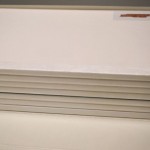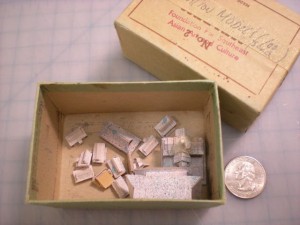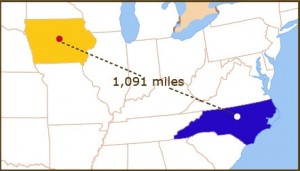 This month the 1091 project is all about enclosures. Boxes. Wrappers. Tuxedos. Clams. You name it, we make it. In fact, last fiscal year we fitted or made over 8,500 enclosures. We love boxes so much we created Boxing Day, which has grown to two days a month.
This month the 1091 project is all about enclosures. Boxes. Wrappers. Tuxedos. Clams. You name it, we make it. In fact, last fiscal year we fitted or made over 8,500 enclosures. We love boxes so much we created Boxing Day, which has grown to two days a month.
I’ve written before about why we create enclosures for our materials. In short it is to protect books from abrasion, dust and light exposure. We also make boxes for artifacts from the collections so that they can safely be put onto a shelf. Most recently these have included a gravestone, death mask, and a teeny tiny Thai Village.
We choose the style of enclosure based on the condition, size, and weight of the object as well as how and how often it is used. Below are the common enclosures we make, listed from the minimum to maximum amount of protection they provide.
We primarily use these polyethylene book jackets for our New & Noteworthy, Duke Authors and Lilly Current Literature books. CoLibri covers make it possible to save publisher’s dust jackets, which often contain unique information such as author biographies and cover art . These take about 3-5 minutes to make.
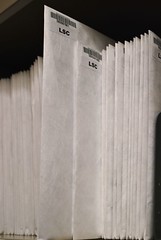 Envelope (buffered paper or Tyvek)
Envelope (buffered paper or Tyvek)
Envelopes provide a minimum of protection for fragile items such as pamphlets. They are inexpensive, easy and quick. For very thin items we will add a stiffener made of a piece of blue-corrugated board or blue-white board.
If the item is very brittle, we will add a folded piece of card stock (folded at the bottom edge) to act as a sling to help get the item out safely. An envelope only takes a couple of minutes to fit and label.
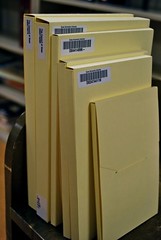 Four flap (aka Tuxedo or Tux box)
Four flap (aka Tuxedo or Tux box)
These are made of 10 or 20 point buffered card stock and are best for small, lightweight items that are between 1/4″ and 1″ thick. They provide protection from light and abrasion and are good for brittle materials or for books with loose boards.
These take on average 10 minutes to make and these (as are the following boxes) are custom cut and folded to fit the book’s exact dimensions.
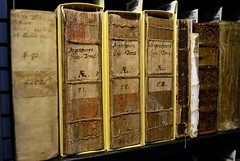 Mylar Spine Four Flap (aka “peekaboo box”)
Mylar Spine Four Flap (aka “peekaboo box”)
Not knowing if an item is inside is a common complaint about boxing books. A good solution is this one, a variation on the traditional four flap but with a polyester spine. While they do tend to have a bit of a gap at the head and tail, they do allow you to see the contents. These boxes obviously do not provide protection from light so they are best for locations that are kept dark except when in use. These take about 10-15 minutes to make.
 Phase Box
Phase Box
Phase boxes, also called “button and string boxes” are perfect for items that need to be restrained to keep them flat. We put vellum-bound materials in these sorts of boxes to keep them from warping. These average 15 minutes to make.
 Drop Spine Box (aka Clam Shell)
Drop Spine Box (aka Clam Shell)
We make these from buffered corrugated board (also called blue clams or “pizza boxes”; bottom of photo) or we make them from binders board and cover them in book cloth (also called “cloth clam”; top of photo).
These provide the most protection for the books inside. They are good for larger, heavier items and for special bindings (e.g. metal clasps, embroidered bindings, etc.). The corrugated boxes take about 15 minutes to make. Depending on their size or complexity the cloth clams can take 90 minutes or more.
Notice the “Return to Conservation after use” sticker on the blue clam. We started putting these on items that we get from Technical Services prior to shelving. This has been a very successful workflow and allows us to provide a box for newly acquired, fragile items while deferring their treatment until they are used. So far we have gotten several back. It’s nice to see patrons using new books in the collection.
We also use a lot of pre-made boxes especially for standard sized manuscript collections or brittle, bound newspapers. Sometimes we need to customize a standard box because the item inside may be a little too small to fit exactly and we don’t want it “swimming” around in the box. In this image, a standard box is given a custom-cut blue-corrugated board insert to keep the brittle newspaper from moving around in the box as it is transported. The papyri rehousing project is a good example of a hybrid project that combines commercially available boxes with custom inserts.
 Creating enclosures is not a one-size-fits-all endeavor. Very often you find yourself having to bring all your skills and experience to a project in order to create something to fit the project’s unique needs.
Creating enclosures is not a one-size-fits-all endeavor. Very often you find yourself having to bring all your skills and experience to a project in order to create something to fit the project’s unique needs.
You can see more interesting boxing projects on our Flickr page. Let’s go over to Parks Library Preservation to see what kind of enclosures they create for their collections.







